
![]()
![]()
| NSF Project Report
DEB-0202175, $195,712, 1 June 2002-31 May 2004 BIODIVERSITY OF SAKHALIN ISLAND INTERNATIONAL SAKHALIN ISLAND PROJECT (ISIP)
|
| GOALS.Following the success of our seven consecutive field-seasons of survey and inventory on the islands of the Kuril Archipelago (see 1994, 1995, 1996, 1997, 1998, 1999, and 2000 NSF Reports), and an initial year on the island of Sakhalin (2001), the primary goal of this two-year grant is to further extend our efforts on Sakhalin: to survey as much of the island as possible in an six-week expedition, focusing on lichens, mosses, liverworts, fungi, vascular plants, insects, spiders, freshwater and terrestrial mollusks, freshwater fishes, amphibians, and reptiles. Additional tasks included the following: (1) sort, identify, and curate whole specimens and ethanol-fixed tissues for future study; (2) develop a database of collection localities, specimens, and taxa for use in later studies; (3) make the immediate results of the surveydatabases, written information, and preserved collectionswidely available as quickly as possible to researchers around the world; (4) provide training, field experience, and research opportunities for students and professional biologists of all three participating nations; and (5) describe new species, publish various articles in the popular and peer-reviewed literature, and prepare keys, guides, and annotated checklists of the biota of Sakhalin Island. Progress to date toward attaining these project goals has been excellent.
|
 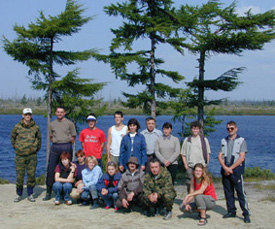 2002 ISIP participants in southern Sakhalin near the Manuy River (left) and northern Sakhalin near the Val River (right). Photos by Pamela Woods.
|
|
RESULTS TO DATE.For these final two years of survey and inventory in the Russian Far East, we decided for logistical reasons to concentrate our collecting efforts in 2002 on aquatic and terrestrial insects, spiders and harvesters, crustaceans, mollusks, freshwater and anadromous fishes, amphibians, and reptiles, and to set lichens, mosses, liverworts, fungi, and vascular plants aside for our final expedition in summer 2003. Instead of relying on a research vessel to provide access to habitats (as was required over the last seven years in the much smaller, individually isolated, and remote Kuril Islands), the 2002 expedition was entirely land-based. From 11 July to 1 September, a team of 27 students and professionals, including seven Americans, twelve Russians, and eight Japanese collected throughout the southern and central part of the island (plans to go to northern Sakhalin and collected especially on the northwest margin of the island were aborted due to severe weather). As in 2001, the primary working facility was a biological field station of the Russian Academy of Sciences, maintained by the Institute of Biology and Soil Sciences, located just outside the village of Sokol, about 50 minutes by car from Yuzhno-Sakhalinsk, the capital city of the island. The station provided all the necessary requirements: sleeping quarters for 28 scientists, adequate laboratory space, and a fully equipped kitchen and support staff. Food and other supplies were readily available at Sokol. Cars and local drivers provided transportation around the island.
|
 Morning over the Uryum River, southwestern Sakhalin Island. Photo by Dan Bennett.
|
|
Collections were made at 525 sites (see Database and Map-based locality record browser) in widely varying habitats, similar to those collected in previous years on the Kuril Islands (see Macro- and microhabitats of the Kuril Islands): from sea-level sandy-, rocky-beach, and grassland to high-mountain stream/conifer forest; from deep, slow-moving lowland rivers to fast-flowing gravelly streams; and from sphagnum bogs to high mountain lakes.
|
 Sunset over Rybnoye Lake in the Val River basin, northern Sakhalin Island. Photo by Noboru Minakawa. Sunset over Rybnoye Lake in the Val River basin, northern Sakhalin Island. Photo by Noboru Minakawa.
|
|
|
|
RESEARCH PRODUCTS.Unlike all previous summers spent in the Far East since 1994, the weather on Sakhalin in July and August 2002 was terrible. High winds and almost continual rain severely hampered collecting effortsmany of the roads were nothing but mud, some impassable, resulting in fewer days in the field and smaller collections compared to past expeditions. Although counts are still preliminary, approximately 34,130 specimens were successfully exported to the U.S. (compared to 67,966 specimens exported in 2001, 41,265 in 2000; 54,177 in 1999; 63,235 in 1998; 53,155 in 1997; 63,700 in 1996; 45,080 in 1995; and 29,600 in 1994):
|
|
Aquatic insects: 4,814 specimens including 9 orders and about 30 families: 521 Coleoptera, 619 Diptera, 149 Ephemeroptera, 132 Hemiptera, 8 Megaloptera, 34 Neuroptera, 138 Odonata, 311 Plecoptera, 2,902 Trichoptera. The total material of five major insect taxa (Coleoptera, Ephemeroptera, Odonata, Plecoptera, and Trichoptera) have already been sent out on loan to specialists around the world, and species-level identifications for these groups are expected soon. The material undoubtedly includes new taxa and many new records. |
  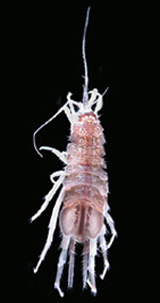 Various specimens: a mecopteran scorpion fly (left), a lepidopteran (top center), the spider Mysenops sp. (bottom center), the isopod Asellus levanidovorum (right). Photos by Dan Bennett and Trevor Anderson (left, top center and bottom center) and Jason Toft (right).
|
 Stand-off between a grasshopper and giraffe beetle. Photo by Trevor Anderson .
|
|
Terrestrial insects: at least 15,500 specimens, representing 12 orders, about 80 families, and well in excess of 500 species; the material undoubtedly includes new taxa and many new records, but much of the collection has not yet been sorted to family. Three insect taxa (braconid Hymenoptera, histerid Coleoptera, and Lepidoptera) have already been sent out on loan to specialists around the world. The material undoubtedly includes new taxa and many new records. Spiders and harvesters: about 5,120 specimens, representing 13 families and at least 80 species; additional new records and perhaps new species may be expected, but most of the material remains unsorted and identified. Crustaceans: About 1,500 of mostly freshwater with some estuarine specimens, including over 17 species of Amphipoda and at least 3 species of Isopoda, with new records and possible new species; additional specimens of Decapoda, Mysidacea and Cumacea, with some probable new records. Freshwater and estuarine zooplankton include at least 5 species of Copepoda. Mollusks: Approximately 100 specimens, with at least 8 species of mostly freshwater and some estuarine specimens. New records or species are unlikely. Freshwater and intertidal fishes: 7,096 specimens, in 10 families, and 37 species; several taxa, known previously from Sakhalin, but new to ISIP collections made in previous years, include Acanthogobius lactipes, Cyprinus carpio, Oncorhynchus kisutch, and Tridentiger kuroiwae.
|

A smelt, Hypomesus sp. Photo by Wataru Abe. |
 A male (top) and female (bottom) Oriental weatherfish Misgurnus anguillicaudatus. Photos by Pamela Woods.
|
|
|
|
The insects, spiders and harvesters, crustaceans, mollusks, fishes, amphibians, and reptiles, are presently being processed here at the University of Washington Burke Museum of Natural History and Culture, and School of Aquatic and Fishery Sciences. General oversight of the insects (i.e., curation, loans and gifts of specimens, data compilation, etc.) is being coordinated by Daniel J. Bennett and Noboru Minakawa (both long-time veterans of our expeditions to the Russian Far East); all entomological material will be archived eventually in the Department of Entomology at the California Academy of Sciences, San Francisco. Curatorial work on the vertebrates is well in hand, but much remains to be done with the invertebrates, despite great progress on insects during the past four years: under Dan Bennett’s direction, assisted by undergraduate Trevor Anderson and others (see Human Resource Development, below), all Hymenoptera and Coleoptera collected since 1994 - well over 50,000 specimens - have now been fully curated (specimens pinned and labeled) and most other groups sorted at least to suborder.
|
 A hill-top view of northern Sakhalin coast. Photo by Wataru Abe.
|
|
Considerable time and effort has gone toward creating, maintaining, and updating our web-site (www.Okhotskia.ws), the heart of which is our search gateway to IKIP and ISIP Databases: (1) Forms-based database search gateway, (2) Map-based locality record browser, and (3) Loans and Gifts of material. Over the past seven years, we have worked hard to make all our data available electronically, but dealing with tens of thousands of specimens, it has been a major undertaking. All of our locality data, from 1994 through 2002, are on-line (8,732 sites on Sakhalin, 30 islands of the Kuril Archipelago, plus the island of Moneron and the mainland of Kamchatka) and we have entered 19,571 taxonomic records. To date, all of the following have been identified, cataloged, and made available on the web-site: all vascular plants, lichens, mosses, liverworts, Odonata, Plecoptera, aquatic Coleoptera, silphid Coleoptera, cerambycid Coleoptera, and Trichoptera collected from 1994 through 1998; Araneae (spiders), Opiliones (harvesters), Acari (mites), Lithobiomorpha (stone centipedes), Ephemeroptera, heteropteran Hemiptera, carabid Coleoptera, phorid Diptera, and formicid Hymenoptera collected from 1994 through 1997; all Cladocera, Dermoptera, Neuroptera, mymarid Hymenoptera, chrysolmelid Coleoptera collected from 1994 through 1999; all fishes, amphibians, and reptiles collected from 1994 through 2002; all Psocoptera, sternorrhynchan Hemiptera, and mollusks collected in 1994 and 1995; all histerid and cholevid Coleoptera collected in 1995; all syrphid Diptera collected in 1997; and all braconid and bethylid Hymenoptera collected in 1996 (see Table 1).
|
|
HUMAN RESOURCE DEVELOPMENT.REU supplemental support was not available this year, but nevertheless two University of Washington undergraduates, Michael J. Cooksey (terrestrial insects) and Cuyler P. Boad (spiders) participated, as did three University of Washington graduate students: Jason D. Toft (crustaceans and mollusks), Pamela J. Woods (fishes), and Daniel L. Garrett (fishes). All received training in fieldwork, curatorial practices, and systematics within their areas of interest. Their experience continues here at home as collections are being sorted and identified, and publications prepared.
|
 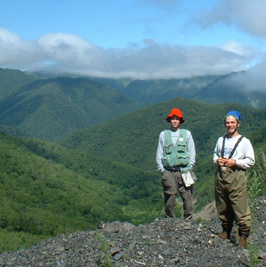 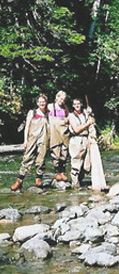 2002 student participants Mike Cooksey (left), Cuyler Boad and Jason Toft (center), and Pamela Woods, Margarita Reimer, and Daniel Garrett (right). Photos by Noboru Minakawa (left and center) and Daniel Garrett (right). |
|
|
|
LOANS AND GIFTS.We have worked hard to make our material available to the international scientific community through loans and gifts of specimens. Altogether over the last nine years, we have made 179 loans and gifts (whole specimens as well as tissues fixed in ethanol) to 116 specialists around the world, totaling 40,892 lots and approximately 229,390 specimens.
|
 Fast-flowing river in southeastern Sakhalin Island, Bakhura River basin. Photo by Mike Cooksey.
|
|
SEMINARS AND MEDIA ATTENTION.We have made a concerted effort to inform academic as well as public audiences about our work through oral presentation, and have received considerable attention from the media in return. To date, veterans of our expeditions to Sakhalin and the Kurils have presented 110 popular and scientific talks (including those papers presented at our “International Symposium on Kuril Island Biodiversity”; for a full overview, click on "International Symposium" from our "Okhotskia" homepage: www.Okhotskia.ws), and have been the subject of some 52 articles in newspapers and magazines. PUBLICATIONS.Although few results relating specifically to Sakhalin have been published to date, one hundred and fifty-eight papers on our work in the Far East have now appeared. An additional two are in press, one submitted, and several others are at various stages of preparation. Forty descriptions of new taxa have been published or are currently in press or submitted for publication: three new species of caddisflies (Trichoptera: Hydroptilidae, Leptoceridae), two new stoneflies (Plecoptera: Perlodidae), one new beetle (Coleoptera: Carabidae), six new flies (Diptera: Phoridae, Scathophagidae, Syrphidae), one new bug (Hemiptera: Miridae), ten new parasitoid wasps (Hymenoptera: Braconidae), one new genus and two new species of mites (Acari: Acaridae, Eviphidae), one new millipede (Diplopoda: Diplomaragnidae), six new freshwater bivalves (Bivalvia: Unionidae, Anodontidae), five new terrestrial and freshwater gastropods (Gastropoda: Planorbidae, Valvatidae), and three new fishes (Teleostei: Osmeridae, Cottidae, Gobiidae).
|
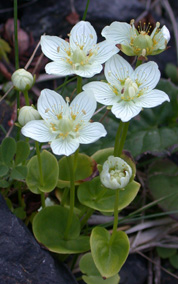  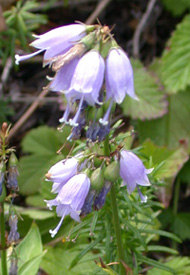 The bog star Parnassia sp. (left), a lizard (center), and ladybells Adenophora pereskiaefolia (right).Photo by Wataru Abe (left and right) and Trevor Anderson (middle).
|
|
|
 Sunset over Rybnoye Lake in northern Sakhalin, Val River basin. Photo by Noboru Minikawa.
|
|
|
 A narrow border between fresh water and the Bay of Mordinova in southeastern Sakhalin Island. Photo by Wataru Abe. |
|
PLANS FOR SUMMER 2003.With NSF funds now in hand for a return to Sakhalin in summer 2003 (approximately 12 July - 7 September), we will concentrate our survey efforts in those parts of the island where lichens, mosses, liverworts, and vascular plants have not been adequately collected: primarily the central and northwestern slope region, north of the Val River, including the western part of the Ainskoe Lake and Okha districts, and in the lowlands of the Tym River basin. Thank you for the generous support we have received. We hope this brief report meets with your satisfaction.
|
|
|
 The poppy Papaver fauriei. Photo by Wataru Abe.
|
|
|
![]()
